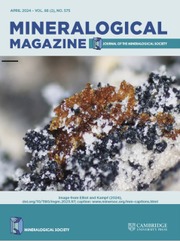No CrossRef data available.
Article contents
How can Li be incorporated into the structure of Al-rich tourmaline?
Published online by Cambridge University Press: 27 June 2025
Abstract
Aluminium-rich tourmaline can contain significant amounts of Li. Until now, syntheses have not been successful in producing Li-rich tourmalines. Because it is still not clear how Li enters the Y site in tourmaline, possible short-range orders, including Li, are discussed using bond valence calculations. Structural arrangement graphs of the Y-site neighbourhood in the structure of elbaitic tourmalines were investigated to determine more information about their stability. Possible short-range ordering including Al and Li at the Y sites, with Na, Ca or □ (vacancy) at the X site, with Si (and Al or B) at the T sites and either (OH) or F at the W site were investigated. Tourmaline with varying amounts of Na but no Ca can only contain ≤1 apfu (atoms per formula unit) YLi. This is consistent with the composition of synthetic tourmaline. Tourmaline with higher Li content (Li >1 apfu) can form when Ca is included. Such tourmaline requires fluorine because more Li results in O1 underbonding, whereas more Al at the Y site leads to O1 overbonding. Underbonding of O1 is preferable for F because OH at the O1 site usually has a bond valence sum (BVS) higher than 1.00 vu (valence units) due to hydrogen bonding of H to ring oxygen atoms. Therefore, liddicoatitic tourmaline is enriched in F and is usually F-dominant. If no fluorine is available in the starting material of a tourmaline synthesis, it is likely that significant proportions of cations such as B and Al will be incorporated into the tetrahedral site. Ultimately, however, only a smaller proportion of Li can be incorporated. Tourmalines with such tetrahedral cations, which also contain a significant Ca content, could theoretically also have significant Y-site vacancies. In order to synthesise Li-rich tourmalines, we would therefore recommend that the starting material also contains both Ca and F.
Keywords
Information
- Type
- Article
- Information
- Copyright
- © The Author(s), 2025. Published by Cambridge University Press on behalf of The Mineralogical Society of the United Kingdom and Ireland.
Footnotes
This paper is part of a collection in tribute to the work of Edward Grew at 80.
Associate Editor: Giancarlo Della Ventura

